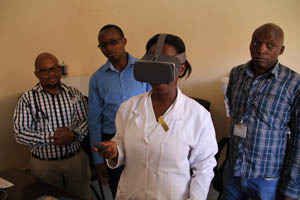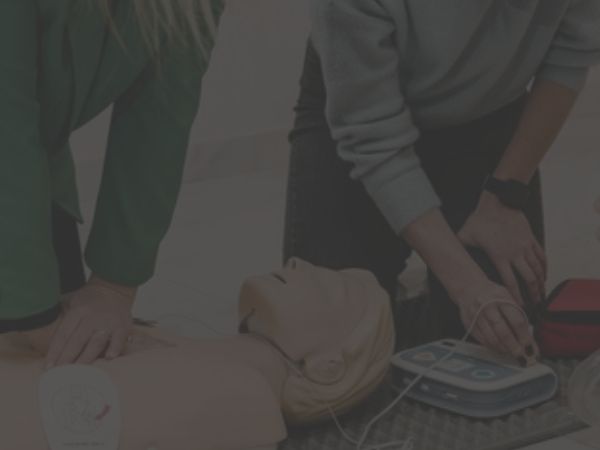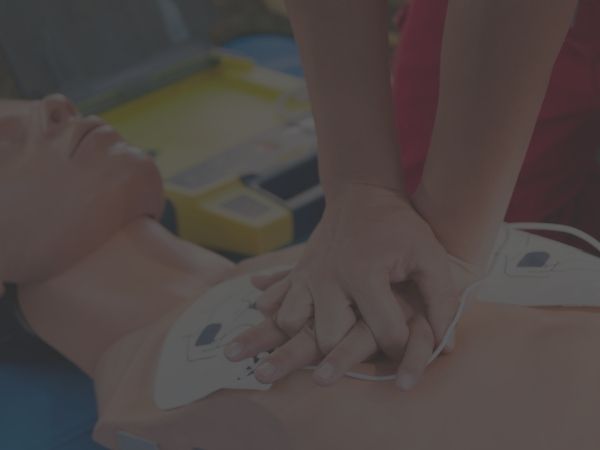Your cart is currently empty!
Virtual Reality CPR Application – Changing the Game for Philanthropy
VIRTUAL REALITY (VR) IS AMONG THE MOST INNOVATIVE TECHNOLOGIES TO AFFECT THE MODERN WORLD, and it has enormous potential for use in philanthropy commissions, medical training and even delivery of health care treatments. National Health Care Provider Solutions had the opportunity to see VR-guided health care instruction in action as part of its joint mission to Nairobi, Kenya for 10 days.
Collaborating with the Foundation for International Cardiac and Children’s Services (FICCS), NHCPS used a new VR health care training app, Dual Good Health, to help educate, train, and empower superusers of basic health care skills, including nurses, medical students, educators and other caregivers.
 The VR application from Dual Good Health uses the Daydream headset, produced by Google, and the features of the Dual Good Health VR application enabled NHCPS to help train people in an interactive setting, used alongside face-to-face instruction. While VR has been out for several years for its entertainment-based features, this marks one of the newest applications of VR in health care.
The VR application from Dual Good Health uses the Daydream headset, produced by Google, and the features of the Dual Good Health VR application enabled NHCPS to help train people in an interactive setting, used alongside face-to-face instruction. While VR has been out for several years for its entertainment-based features, this marks one of the newest applications of VR in health care.
Since the VR application was so well received and helped FICCS touch the lives of even more people in areas of the world that lack access to health care, please take a moment to learn a few things about the new application, the Daydream headset, and the possibilities of VR in health care.
What Is Dual Good Health, and How Does It Work?
Dual Good Health is a company that uses VR technology, such as the Daydream Standalone, to teach first aid, basic life support (BLS), automated external defibrillation (AED) and other emergency training courses through engaging scenario simulation, situational awareness in performing skills, practical training, and ongoing software updates and support.
Dual Good Health VR users can take advantage of full step-by-step tutorials and practices, complete with simulation, showing necessary chest depth for compression, beats per minute, and other key factors in performing CPR, BLS and AED safely.
Consider this example. In a traditional classroom setting, the instructor always emphasizes the need to ensure the safety of a situation prior to providing assistance or CPR. In a classroom setting, it is difficult to emphasize the need to check the scene for safety due to basic classroom limitations. However, the Dual Good Health app uses simulation to present a safety obstacle and show how it may be removed safely, enabling the successful administration of CPR or BLS.
In the Dual Good Health app, users are presented with a safety risk of a downed electrical line near the victim, and users must use a wooden stick to move the electrical line away from the victim before the simulation will allow the user to proceed.
Upon completion of the VR simulation, users can then complete a quiz or other evaluation to ensure the competency of skills. Meanwhile, the software tracks the user’s emotions and actions to provide a graded level of competency for his or her responsiveness and skill within the training program.
What Type of Headset Is Required to Use the Dual Good Health Virtual Reality App?
Dual Good Health software can be used with two different types of VR heads, including the Google Daydream Standalone and the HTC Vive. The HTC Vive requires a PC and additional controllers to track hand, but this results in limited availability in remote settings. While traveling to Nairobi, Kenya, NHCPS used the Daydream Standalone headset, which has the added benefits of being light and easy to transport, requiring minimal installation and updating and is more cost-efficient than the HTC option.
When Will Daydream Standalone Be Widely Available?
The Daydream Standalone VR headset was expected to be released in December 2017, but as of February 6, 2018, Google and Lenovo have not yet fully released the hardware to the public. VR app developers and software creators, such as Dual Good Health, can take advantage of pre-launch use of the Daydream Standalone headset.
Is There a Smartphone Daydream Headset?
Users can purchase the Smartphone VR Daydream headset, Daydream View, which is designed to work with some of the most popular smartphones on the market, including the Google Pixel 2, Samsung Galaxy S8 & S8+, Asus Zen phone AR, and the LG V30. Dual Good Health is expected to create an additional version of their software that can be used with the smartphone Daydream VR headset soon.
Once the Daydream Standalone very our headset is fully launched, it will be widely used as part of the Dual Good Health app. Since the Daydream Standalone does not require any wires, PCs, connections, or other devices to function, it is best suited for users that have continually changed locations. Therefore, NHCPS used the Daydream Standalone headset while in Kenya.
What Are the Benefits and Possibilities of VR-Guided Health Care Training?
Take a moment to think about the basic principles of training in health care. People must undergo a rigorous training before they can practice their profession, whether it be nursing, medicine, or even a type of therapy. For all health care professionals, ongoing, recurring CPR, BLS, and AED training is essential. The possibilities of VR guided health care training is quite extensive and included these key benefits.
It Is Accessible in Virtually Any Setting
Unlike traditional health care training, VR-guided health care training is accessible in virtually any setting. Even using online training programs, such as NHCPS AED, CPR, and First Aid has a slight hurdle when it comes to accessing the program in remote regions. Modern smart devices may require ample energy to overcome the glare of sunlight, and depending on the Internet connection, accessing the program may be difficult.
Imagine this scenario applied to a VR-guided simulation. The VR headset filters out light, so it requires less energy to function, and since the software does not rely on an Internet connection, it can be used in areas with limited resources and lacking infrastructure.
The Program Can Be Adapted to Teach Different Life-Saving Skills
The use of VR can also be adapted to teach different life-saving skills, not just CPR, first aid, ADD and BLS. As explained by Wendy Powell via Phys.org, VR immerses the user a realistic simulation of a health care procedure or practice. The user can make the exact movements he would make when providing care to a real person.
Although Dual Good Health is applied to teaching the basic life-saving skills, VR as a technology holds great potential for training doctors, nurses, surgeons, therapists, and just about anyone else in the health care field. It is an amazing technology that can also revolutionize basic trauma treatment, allowing for immediate assessment of individuals injuries and ensuring health care providers stabilize a person as quickly as possible.
It Provides an Interactive Experience
As noted previously, VR users learn while practicing skills. As the country faces a growing nursing shortage, the use of VR can be applied to help train and educate more nurses. In some rural areas with limited nursing programs available, students will be able to slip on a VR headset and get involved in the learning experience. Moreover, and interactive experience has the benefits of enhancing memorability. In other words, interactive experiences are more likely to be remembered in the long-term memory, so students and users can spend less time studying and more time learning in an interactive application.
VR-Guided Health Care Training Evaluates Performance to Ensure Competency
A VR guided health care training simulation goes further than just teaching skills; it ensures basic competency. While existing quizzes and exams upon completion of a CPR, AED, or BLS course exist, VR guided health care training environments can assess more than just memory recall. They evaluate the ability of the user to perform compressions at the appropriate rate. They force the user to make the movements and actions necessary to adjust the airway, look, listen, and feel for breathing. and check for signs of circulation.
VR Can Be Used Alongside Face-to-Face Training
A virtual learning environment is a fantastic opportunity for students looking to learn more about their profession and ensure they have the right skill set necessary to give care. While a VR headset can provide training independently of face-to-face training, it can also be used in conjunction with face-to-face training programs, allowing a user to experience the potential dangers and movements necessary within a training program. This encourages muscle memory and helps individuals prepare for using their skills in real-time. This is the same concept that is applied in face-to-face training when using a manikin to teach CPR and BLS, but it takes it to a higher level by evaluating an individual’s performance, as well as allowing the student to learn in a traditional face-to-face scenario.
A Virtual Environment Reduces Training Costs
Speaking of differences between traditional face-to-face learning environments and VR, VR training has the added benefits of being more cost-efficient than traditional training programs. Since the headset functions autonomously, the instructor can focus on teaching skills to students struggling to learn. This allows instructors to teach more students, faster than ever before, and in areas of the world with limited access to health care, like Africa, being able to teach one more person will mean the difference between life and death for someone.
Practicing Skills in VR Results in Better Responsiveness and Skill in Real-Life Scenarios
Having the opportunity to practice skills in a virtual environment will give a person confidence when presented with a life-threatening situation of sudden cardiac arrest or another emergency. According to the International Liaison Committee on Resuscitation (ILCOR), more than 383,000 cases of cardiac arrest occur each year outside of a hospital, and most victims do not show preemptive symptoms of cardiac arrest. This means that most of the people experiencing cardiac arrest may not show warning signs, and being able to act as that person’s lungs and heart for a short time is essential to his or her survival.
The Future of VR in Health Care Is Limitless!
According to Powell, VR is set to reshape health care standards, delivery of treatment, and training. Some of the more exciting applications of VR in health care include:
-
- VR Guided Physical Therapy. This application of VR could be helpful for individuals with limited access to therapy centers, such as rural areas.
- Cognitive Rehabilitation. For individuals suffering from a stroke or traumatic brain injury, VR may be used to help retrain the brain and learn basic life skills. While it has not yet been researched, the application of VR for cognitive rehabilitation may help those suffering from addiction learn new coping skills and overcome their addictions.
- Cognitive Behavioral Therapy. Individuals suffering from immense, irrational fears and phobias could use VR as a means of desensitization, a component of cognitive-behavioral therapy, to overcome such fears.
- Continuing Education and “Skills Fairs.” For large-scale hospitals and health care organizations, annual continuing education costs, even when conducted in a “fair” setting, could decline by providing on-the-go skills checks and competency evaluation for team members at virtually any time. Pardon the pun.
- VR Applications May Be Useful in Treatment of Pain. Some studies even suggest that the use of virtual reality can help distract the brain when experiencing pain. This could have a revolutionary impact on treatment that results in intense pain.
What About Training for Non-Health Professionals?
The Dual Good Health App is great for non-health professionals as well. Individuals with limited health care experience can learn the basics of CPR, BLS, and AED in minutes, compared to hours-long classroom training. Used in conjunction with face-to-face training, Dual Good allows for better competency measurement, skill check and guided instruction.
Discover the Humanity and Excitement of Learning How to Save a Life Today.
The state of health care training is evolving, and authoritative sources, including the ILCOR, continue to push the need for more CPR, AED and BLS training to reduce mortality rates in the U.S. On a global scale, the benefits of these basic health care training courses can literally mean the difference between life and death, especially in regions with limited access to health care. You can make a difference too.
Sign up for an online CPR, AED, or First Aid course today, and consider becoming part of the movement toward VR-guided health care training with Dual Good. Imagine how all CPR training may one day use a combination of VR, face-to-face training, and classroom instruction to touch more lives and have a greater positive impact. This is exactly what NHCPS did as part of our trip to Kenya, empowering superusers. We just can’t wait to see what the future of VR-assisted health care holds.










Leave a Reply